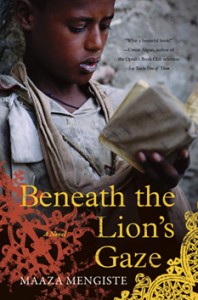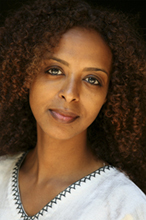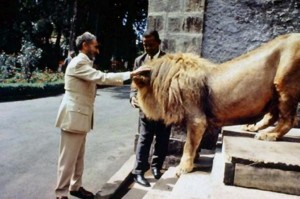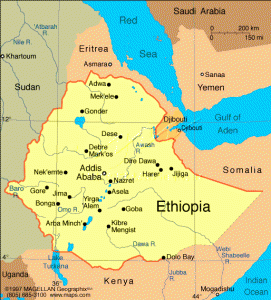“Once I was beloved of God, the King of Kings. I was the Conquering Lion of Judah, a descendant of King Dawit. My blood, rich and red, is kin to that other King of Kings, the most Beloved. I ruled my kingdom in honor of His.…Ethiopia, the most loved of the Beloved, do you hear the drums above the clouds? Do you know that angels approach, and they come for you?”—Haile Selassie, the Lion of Judah, 1974.
Maaza Mengiste’ s remarkable debut novel, set in her home country of Ethiopia in 1974, brings to life the historical period from the assassination of Emperor Haile Selassie through the communist revolution and the subsequent resistance movement which followed shortly on its heels. The Emperor had failed to recognize and take action to mitigate the horrific famine which had cost two hundred thousand lives. A well-publicized 1974 television documentary, showing the educated Ethiopian public the horrors of famine in the remote areas of their country, juxtaposed against films of the wasteful excesses of palace functions, set the country up for revolution. Initially planned by students who wanted more accountability and change, the revolution was soon pre-empted by the strong military, which had its own agenda. Within a year, the ultra-right , known as the Derg, was in charge of the country, the military consolidating its power while arresting many of the students who had made the revolution possible.
s remarkable debut novel, set in her home country of Ethiopia in 1974, brings to life the historical period from the assassination of Emperor Haile Selassie through the communist revolution and the subsequent resistance movement which followed shortly on its heels. The Emperor had failed to recognize and take action to mitigate the horrific famine which had cost two hundred thousand lives. A well-publicized 1974 television documentary, showing the educated Ethiopian public the horrors of famine in the remote areas of their country, juxtaposed against films of the wasteful excesses of palace functions, set the country up for revolution. Initially planned by students who wanted more accountability and change, the revolution was soon pre-empted by the strong military, which had its own agenda. Within a year, the ultra-right , known as the Derg, was in charge of the country, the military consolidating its power while arresting many of the students who had made the revolution possible.

Mengiste’s novel takes a careful look at these times, reducing the grand scale of the disastrous famine and its political aftermath to understandable human terms by concentrating on one family and its friends and acquaintances in Addis Ababa, the capital. Hailu, a physician, and his very sick wife, Selam, have two sons, Yonas, who is thirty-two, and Dawit, age twenty-four, a college student. Dawit inevitably becomes active in revolutionary activities which result in the overthrow of the emperor. Yonas, much less active in political affairs, is more concerned with maintaining his wife Sara and his four-year-old daughter Tizita. Their family, friends, employees, and acquaintances, seen in lively and often moving scenes, provide a multi-leveled view of the country in 1974.
The quick military support for “the Derg” by both Cuba and the Soviet Union soon leads the country’s powerful new leaders into excess, and everyone mistrusts everyone else. A “War of Annihilation” against any form of opposition is accompanied by the executions of former governmental heroes, the takeover of private enterprise, clampdowns on free speech, arrests and torture for suspected infractions, and many deaths. The government is also waging war on two fronts—Somalia and Eritrea.

The Lion of Judah pats one of his palace lions.
The author enlivens her often grim narrative by creating characters with whom the reader can identify, providing the small, realistic details which make the characters feel like people we know. The grand-scale problems of Ethiopia are examined within the smaller contexts of parent/child disagreements, sibling rivalries, romantic conflicts, jealousies, and simmering resentments against people who have ignored their roots in their drive for power. As the characters gradually become drawn into the larger political conflicts of the country, the reader is shocked by the extreme cruelty, both physical and emotional, of those who are in power. The events of the novel are often tied to the characters’ spiritual or religious backgrounds, with history, traditional values, and signs from nature playing a large part in explaining the characters’ behavior and motivations. The seemingly random attacks by the military’s “thought police” create overwhelming public fear, and the deliberate manipulation of the public’s psychology makes normal life impossible.
 The novel is well constructed, with characters the reader comes to care about, but it is difficult to read. The violence, which increases in intensity over the course of three hundred pages, involves false arrests, beatings, rapes, psychological warfare, brutal tortures in an effort to extract sometimes non-existent information, and the mutilation of women and children. Some scenes involving the maiming of a child are almost impossible to read. The author’s dedication to presenting a full picture of the almost inhuman behavior of the country’s powerful leaders and misguided followers, however, creates unforgettable tableaux, and makes the reader hope for a better future in the aftermath of this action.
The novel is well constructed, with characters the reader comes to care about, but it is difficult to read. The violence, which increases in intensity over the course of three hundred pages, involves false arrests, beatings, rapes, psychological warfare, brutal tortures in an effort to extract sometimes non-existent information, and the mutilation of women and children. Some scenes involving the maiming of a child are almost impossible to read. The author’s dedication to presenting a full picture of the almost inhuman behavior of the country’s powerful leaders and misguided followers, however, creates unforgettable tableaux, and makes the reader hope for a better future in the aftermath of this action.
Notes: The author’s photo is from her website: http://maazamengiste.com/
The photo of Haile Selassie, the Lion of Judah, is from http://www.ethiopicture.com
The map of Ethiopia is on http://www.adoptionavenues.org
